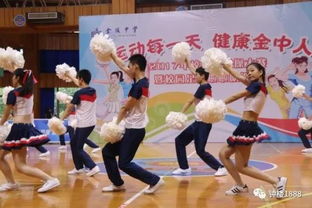您所在的位置:首页 - 问答 - 正文问答
拉拉队跳的是健美操吗
![]() 国玺
2024-05-12
【问答】
488人已围观
国玺
2024-05-12
【问答】
488人已围观
摘要**Title:EffectiveTrainingMethodsforCheerleadingandGymnastics****Introduction**Cheerleadingandgymnast
Title: Effective Training Methods for Cheerleading and Gymnastics
Introduction
Cheerleading and gymnastics are demanding sports that require a combination of strength, flexibility, coordination, and teamwork. Training for these sports involves a variety of exercises and techniques aimed at improving physical fitness and mastering specific skills. In this guide, we will explore effective training methods for cheerleading and gymnastics, focusing on key areas such as strength training, flexibility, skill development, and teamwork.
Strength Training
Strength is essential for performing various stunts and routines in cheerleading and gymnastics. A comprehensive strength training program should target all major muscle groups, including the core, upper body, lower body, and stabilizing muscles. Exercises such as squats, lunges, pushups, pullups, and planks are beneficial for building overall strength.
In addition to traditional strength training exercises, cheerleaders and gymnasts can incorporate plyometric exercises to improve explosive power and agility. Plyometric exercises like box jumps, depth jumps, and medicine ball throws help enhance muscle power and coordination, which are crucial for executing dynamic movements and jumps.
It's important to progressively overload the muscles by gradually increasing the intensity, duration, or resistance of exercises over time. This allows athletes to continuously challenge their muscles and make gains in strength.
Flexibility Training
Flexibility is another key component of cheerleading and gymnastics, as it enables athletes to achieve proper body alignment, perform complex skills, and reduce the risk of injuries. A regular stretching routine should include dynamic stretches to warm up the muscles before activity and static stretches to improve flexibility and range of motion.
Dynamic stretches involve moving the body through a full range of motion in a controlled manner, while static stretches involve holding a position for a prolonged period to lengthen the muscles and connective tissues. Stretching should target all major muscle groups, with a focus on areas prone to tightness such as the hamstrings, hip flexors, shoulders, and back.
Yoga and Pilates can also be beneficial for improving flexibility, balance, and body awareness. These practices incorporate various stretching and strengthening exercises that promote mobility and stability, making them valuable additions to a cheerleading or gymnastics training regimen.
Skill Development
Mastering specific skills is essential for success in cheerleading and gymnastics. Skill development should be broken down into progressive steps, starting with basic techniques and gradually advancing to more complex maneuvers. Coaches should provide clear instructions, demonstrations, and feedback to help athletes understand and execute each skill correctly.
Drills and repetition are key components of skill development, allowing athletes to reinforce proper technique and build muscle memory. Breaking down skills into smaller components and focusing on one aspect at a time can help athletes overcome challenges and improve their overall performance.
It's also important to emphasize safety and proper spotting techniques when learning new skills, especially those involving high levels of difficulty or risk. Spotting involves a trained coach or teammate providing assistance and support to help ensure the safety of the athlete during skill practice and performance.
Teamwork
Cheerleading and gymnastics are teamoriented sports that require effective communication, trust, and collaboration among team members. Teamwork training should focus on building camaraderie, unity, and synchronization among athletes, enabling them to perform cohesive routines and support each other both on and off the mat.

Group exercises, partner drills, and teambuilding activities can foster a sense of camaraderie and trust within the team. Encouraging open communication, positive reinforcement, and mutual respect among athletes cultivates a supportive team environment where everyone feels valued and included.
Team practices should include opportunities for athletes to work together on synchronized movements, timing, and formations. By practicing together as a team, athletes can develop a strong sense of cohesion and unity, which is essential for delivering polished performances and achieving success in competitions.
Conclusion
Effective training for cheerleading and gymnastics encompasses a combination of strength training, flexibility, skill development, and teamwork. By implementing comprehensive training programs that address these key areas, athletes can enhance their physical fitness, master specific skills, and perform at their best both individually and as part of a team. With dedication, hard work, and proper guidance from coaches, cheerleaders and gymnasts can achieve their goals and excel in their sport.
Tags: 天华百剑斩 木叶忍者村 黑客狙击手 网络游戏工作室
版权声明: 感谢您对【万怡经验网】网站平台的认可,无特别说明,本站所有文章均归【万怡经验网】平台所有,转载请说明文章出处“来源【万怡经验网】”。 https://hangzhou-wyhotel.com/post/18803.html
上一篇: 景德镇餐饮标书制作公司
下一篇: 健美造型
最近发表
- 大哥们吃夜宵遇大风,帮摊主护住摊位
- 媒体,甲亢哥不仅让世界认识中国
- 专家,地球没有进入震动模式
- 缅甸反政府武装停火两周配合救灾,一场人道主义行动的背后
- 华为阔折叠屏手机,10分钟缺货背后的科技魅力与市场需求
- 小马科斯姐姐,杜特尔特权利被侵犯
- 中俄携手,共筑海上生命线,救援搁浅中国货船的故事
- 120余名一把手配偶同上清廉课,携手共建廉洁家风
- 泽连斯基,愿和普京直接谈判
- 在缅中国人,房屋倒塌,很多没人敢进屋
- 女子傍晚拍到绝美红日,探索自然之美与摄影艺术的融合
- 幼升小和小升初招生入学有哪些利好
- 赵露思在节目中出现脑雾反应,揭示公众人物压力下的心理健康挑战
- 女子花3万购买应援品发给刀郎粉丝,一场跨越年龄与文化的音乐共鸣
- 特朗普为何要主动攻击胡塞武装?
- 超市商品质量,于东来的垃圾商品论与我们的反思
- 黎以战火又起,中东战火会否再升级?
- 经典永存,怀念余情未了演唱者李国祥
- 刀郎武汉演唱会,一曲虞美人故乡唤醒了多少人的乡愁
- 在缅华人,废墟下有很多求救声
- 探寻真相,胡塞发言人将儿子送往中国是否属实?
- 台退将的声明,真正支援缅甸,或许只有中国能做到
- 特朗普称援缅却裁撤国际开发署,政策矛盾与国际援助的困境
- 专家,美打击胡塞面临深陷泥潭风险
- 泰国节目直播遇地震,女演员被吓哭,观众却从中看到了人性的温暖
- 打造品牌魅力,品牌推广部的魔法指南
- 小米汽车发布一周年,回顾与展望
- 亚洲学术地图,探索顶尖学府的璀璨星辰——揭示亚洲大学100强的影响力与未来趋势
- 缅甸地震,灾难中的坚韧与希望
- 中国前驻美大使,特朗普言行不一致
- 掌握谷歌关键词工具,SEO优化的秘密武器与实践指南
- 小米官宣YU7,名字背后的深意与未来展望
- 沙滩烤肉大冒险,户外烹饪的乐趣与技巧解析
- 曝董宇辉下播后险被砸,直播行业的安全警钟
- 广州SEO优化,通往线上繁华的黄金钥匙——打造你的电商帝国
- 美防长公然叫嚣重建对中国武力威慑,一场不切实际的幻想
- 为什么有钱人都在清仓
- 穿越语言的桥梁,探索修曼日本语学校的魅力与价值
- 林允儿在公共场合被臭到表情失控,一场意外的尴尬瞬间
- 连连看,你的生活小助手——免费下载的快乐与智慧并存
- 白鲸被教微笑服务后朝饲养员吐水,海洋智慧与人类情感的奇妙互动
- 轻点几下,形象升级,如何在腾讯会议中个性化你的在线形象
- 近期有草莓瘟不能吃草莓?官方辟谣
- 探索虚拟世界的魅力,超级QQ秀的魅力与影响
- 万象耕新 奏响春耕进行曲
- Manus公布收费方案,探索其背后的逻辑与影响
- 探索宠物连连看30的魅力,一款激发智力与爱心的游戏之旅
- 房价又一轮大变局开始了
- 提升在线影响力,巩义网站优化的策略与实践指南
- 缅甸地震,全球今年来最大地震的震撼与启示



